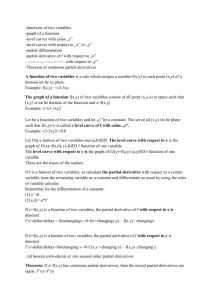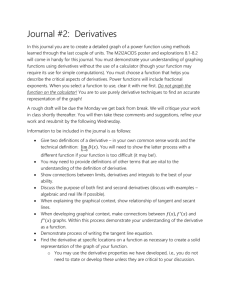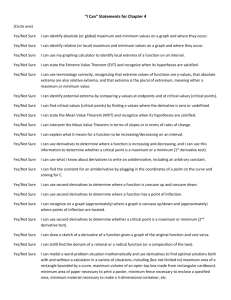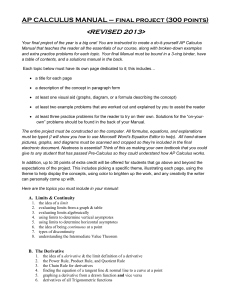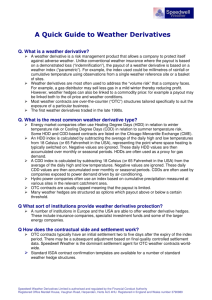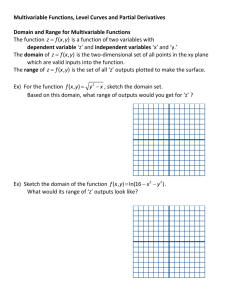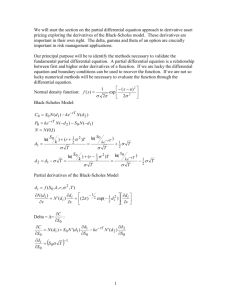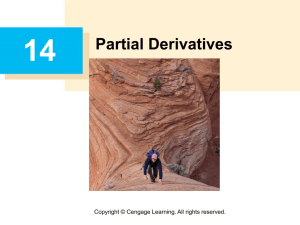Math Review
advertisement
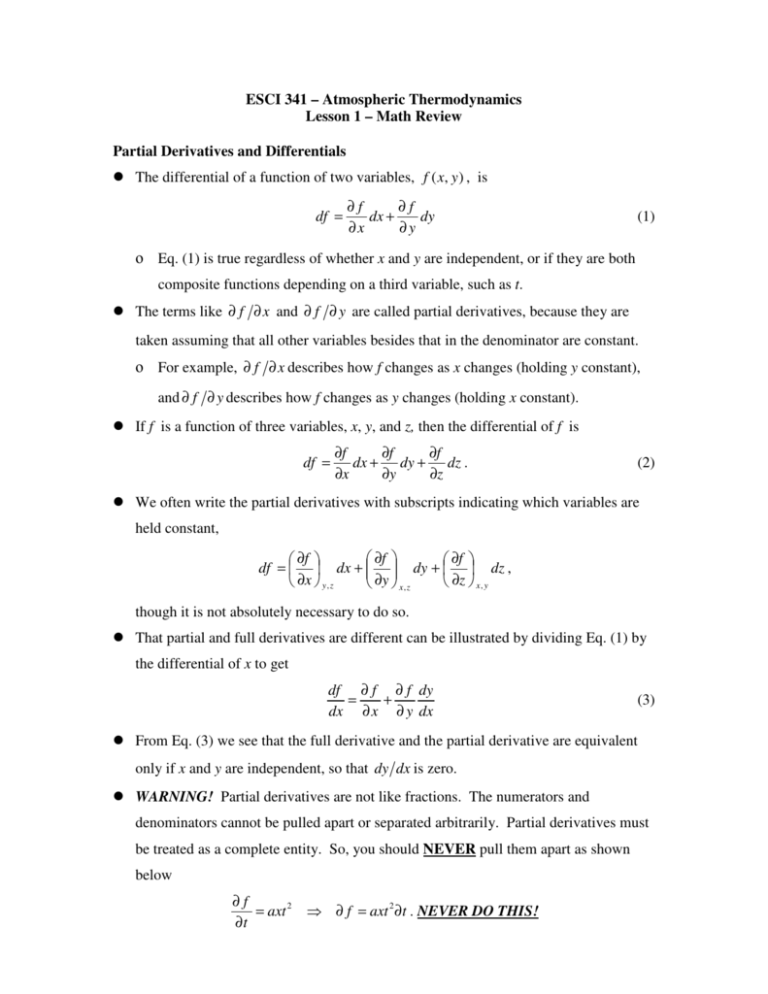
ESCI 341 – Atmospheric Thermodynamics Lesson 1 – Math Review Partial Derivatives and Differentials The differential of a function of two variables, f ( x, y ) , is df = ∂f ∂f dx + dy ∂x ∂y (1) ο Eq. (1) is true regardless of whether x and y are independent, or if they are both composite functions depending on a third variable, such as t. The terms like ∂ f ∂ x and ∂ f ∂ y are called partial derivatives, because they are taken assuming that all other variables besides that in the denominator are constant. ο For example, ∂ f ∂ x describes how f changes as x changes (holding y constant), and ∂ f ∂ y describes how f changes as y changes (holding x constant). If f is a function of three variables, x, y, and z, then the differential of f is df = ∂f ∂f ∂f dx + dy + dz . ∂x ∂y ∂z (2) We often write the partial derivatives with subscripts indicating which variables are held constant, ∂f ∂f ∂f df = dx + dy + dz , ∂x y , z ∂z x , y ∂y x , z though it is not absolutely necessary to do so. That partial and full derivatives are different can be illustrated by dividing Eq. (1) by the differential of x to get df ∂ f ∂ f dy = + dx ∂ x ∂ y dx (3) From Eq. (3) we see that the full derivative and the partial derivative are equivalent only if x and y are independent, so that dy dx is zero. WARNING! Partial derivatives are not like fractions. The numerators and denominators cannot be pulled apart or separated arbitrarily. Partial derivatives must be treated as a complete entity. So, you should NEVER pull them apart as shown below ∂f = axt 2 ∂t ⇒ ∂ f = axt 2 ∂t . NEVER DO THIS! With a full derivative this is permissible, because is it composed of the ratio of two differentials. But there is no such thing as a partial differential, ∂f . THE CHAIN RULE If x and y are not independent, but depend on a third variable such as s [i.e., x( s ) and y ( s ) ], then the chain rule is df ∂f dx ∂f dy = + . ds ∂x ds ∂y ds (4) If x and y depend on multiple variables such as s and t [i.e., x( s, t ) and y ( s, t ) ], then the chain rule is ∂f ∂f ∂x ∂f = + ∂s ∂x ∂s ∂y ∂f ∂f ∂x ∂f = + ∂t ∂x ∂t ∂y ∂y ∂s . ∂y ∂t (5) THE PRODUCT RULE AND THE QUOTIENT RULE The product and quotient rules also apply to partial derivatives: ο The product rule ∂ ∂v ∂u ( uv ) ≡ u + v . ∂x ∂x ∂x (6) ∂ u 1 ∂u ∂v ≡ 2 v −u . ∂x v v ∂x ∂x (7) ο The quotient rule PARTIAL DIFFERENTIATION IS COMMUTATIVE Another important property of partial derivatives is that it doesn’t matter in which order you take them. In other words ∂ ∂f ∂ ∂f ∂ 2 f ∂2 f ≡ ≡ ≡ . ∂x ∂y ∂y ∂x ∂x∂y ∂y∂x Multiple partial derivatives taken with respect to different variables are known as mixed partial derivative. 2 OTHER IMPORTANT IDENTITIES The reciprocals of partial derivatives are: ∂f 1 ; = ∂y x ∂y ∂f x 1 ∂f = ∂x y ∂x ∂f y If a function of two variables is constant, such as f ( x, y ) = c , then its differential is equal to zero, ∂f ∂f df = dx + dy = 0 . ∂x y ∂ y x (8) ο In this case, x and y must be dependent on each other, because in order for f to be a constant, as x change y must also change. For example, think of the function f ( x, y ) = x 2 + y = c . (9) ο Eq. (8) can be rearranged to ∂ f dx ∂ f + =0. ∂ x y dy ∂ y x (10) The derivative dx dy in Eq. (10) is actually a partial derivative with f held constant , so we can write ∂ f ∂x ∂ f + =0, ∂ x ∂ y ∂ y y f x which when rearranged leads to the identity ∂f ∂y ∂x = −1 . ∂x y ∂f x ∂y f ο Eq. (11) is only true if the function f is constant, so that df = 0. 3 (11) INTEGRATION OF PARTIAL DERIVATIVES Integration is the opposite or inverse operation of differentiation. b ∂ f ( s, t ) ds = f (b, t ) − f (a, t ) s ∂ a ∫ b ∂ f ( s, t ) ∫a ∂t dt = f ( s, b) − f (s, a) (12) DIFFERENTIATING AN INTEGRAL If an integration with respect to one variable is then differentiated with respect to a separate variable, such as b ∂ f ( s, t , u )ds ∂t ∫a the result depends on whether or not the limits of integration, a and b, depend on t. In general, if both a and b, depend on t, the result is b ( t ,u ) b ( t ,u ) ∂ ∂ f ( s, t , u ) ∂b ∂a f ( s, t , u )ds = ∫ ds + f (b, t , u ) − f (a, t , u ) . ∫ ∂ t a ( t ,u ) ∂ t ∂ t ∂ t a ( t ,u ) (13) ο If a does not depend on t then the term in Eq. (13) that involves ∂a ∂t will disappear. Likewise, if b does not depend on t, then the term containing ∂b ∂t will be zero. 4



